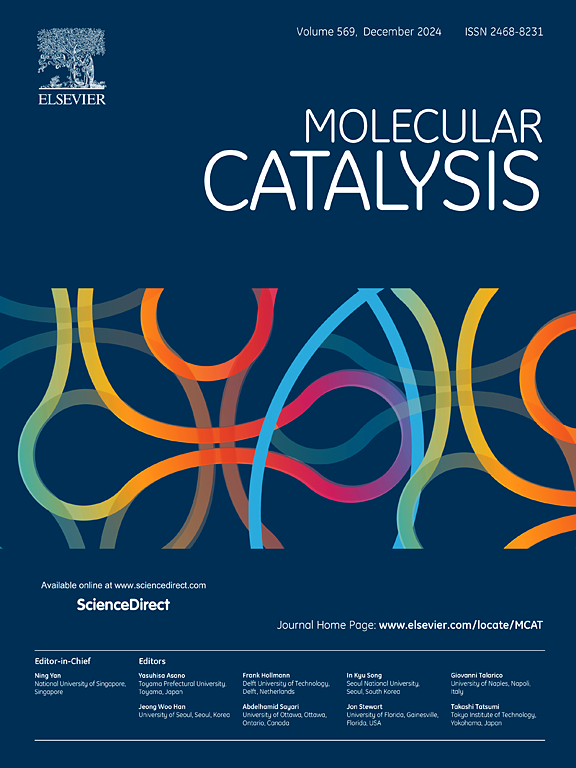嵌入镍-金属富勒烯(Nin@C60)作为CO可控C-C偶联的有效催化剂
IF 3.9
2区 化学
Q2 CHEMISTRY, PHYSICAL
引用次数: 0
摘要
CO的CC偶联在CO/CO2还原为C2+化合物中起着至关重要的作用。控制催化剂的活性和活性位点是实现可控CC耦合的有效方法。通过将金属掺杂到富勒烯中形成内嵌金属富勒烯(EMF),可以获得独特的催化活性。本文报道了嵌入镍-金属富勒烯(Nin@C60)作为一种高效催化剂,可以实现CO的可控CC偶联,从而促进C2产物的生成。结果表明,Nin簇嵌入C60形成Nin@C60在热力学上是可行的,电子结构分析表明,Nin簇可以通过电子转移激活C60。随后研究发现,C60和Nin@C60表面物理吸附的CO可通过可控的CC耦合直接形成O*C*CO中间体,具有极低的活化能垒(0.10 ~ 0.41 eV)。其中Ni6@C60的活化能势垒最低,为0.10 eV。这项工作为CC可控耦合和新型CO/CO2高效转化催化剂的设计提供了新的理论见解。本文章由计算机程序翻译,如有差异,请以英文原文为准。
Embedded nickel-metallofullerenes (Nin@C60) as an effective catalyst for controlled C-C coupling of CO
The C![]() C coupling of CO plays a crucial role in the reduction of CO/CO2 to C2+ compounds. Controlling the activity and active sites of the catalyst proves to be an effective method to achieve controllable C
C coupling of CO plays a crucial role in the reduction of CO/CO2 to C2+ compounds. Controlling the activity and active sites of the catalyst proves to be an effective method to achieve controllable C![]() C coupling. By doping metals into fullerene to form endohedral metallofullerenes (EMF), a strategy emerges to achieve unique catalytic activity. Herein, we report that embedded nickel-metallofullerenes (Nin@C60) as an efficient catalyst can achieve controllable C
C coupling. By doping metals into fullerene to form endohedral metallofullerenes (EMF), a strategy emerges to achieve unique catalytic activity. Herein, we report that embedded nickel-metallofullerenes (Nin@C60) as an efficient catalyst can achieve controllable C![]() C coupling of CO, thereby promoting the generation of C2 products. The results show that it is thermodynamically feasible for Nin clusters to embed into C60 to form Nin@C60, electronic structure analysis reveals that Nin clusters can activate C60 through electron transfer. Subsequently, research finds that the physically adsorbed CO on C60 and Nin@C60 surface can directly form O*C*CO intermediate through controllable C
C coupling of CO, thereby promoting the generation of C2 products. The results show that it is thermodynamically feasible for Nin clusters to embed into C60 to form Nin@C60, electronic structure analysis reveals that Nin clusters can activate C60 through electron transfer. Subsequently, research finds that the physically adsorbed CO on C60 and Nin@C60 surface can directly form O*C*CO intermediate through controllable C![]() C coupling, with an extremely low activation energy barrier (0.10 ∼ 0.41 eV). Among them, Ni6@C60 has the lowest activation energy barrier, which is 0.10 eV. This work provides new theoretical insights into C
C coupling, with an extremely low activation energy barrier (0.10 ∼ 0.41 eV). Among them, Ni6@C60 has the lowest activation energy barrier, which is 0.10 eV. This work provides new theoretical insights into C![]() C controllable coupling and the design of novel catalysts for efficient CO/CO2 conversion.
C controllable coupling and the design of novel catalysts for efficient CO/CO2 conversion.
求助全文
通过发布文献求助,成功后即可免费获取论文全文。
去求助
来源期刊

Molecular Catalysis
Chemical Engineering-Process Chemistry and Technology
CiteScore
6.90
自引率
10.90%
发文量
700
审稿时长
40 days
期刊介绍:
Molecular Catalysis publishes full papers that are original, rigorous, and scholarly contributions examining the molecular and atomic aspects of catalytic activation and reaction mechanisms. The fields covered are:
Heterogeneous catalysis including immobilized molecular catalysts
Homogeneous catalysis including organocatalysis, organometallic catalysis and biocatalysis
Photo- and electrochemistry
Theoretical aspects of catalysis analyzed by computational methods
 求助内容:
求助内容: 应助结果提醒方式:
应助结果提醒方式:


